16 Proficiency Interviews 3
PI-3: Two-way prepositions
In Chapters 2 and 3, you learned the accusative and dative prepositions.
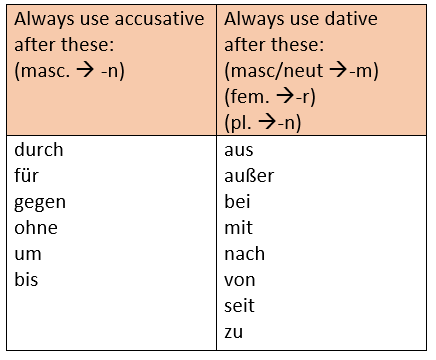
In this section, you will learn several new prepositions that will take either the accusative or the dative case based on how they are used.
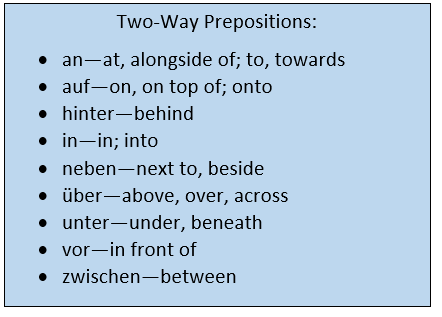
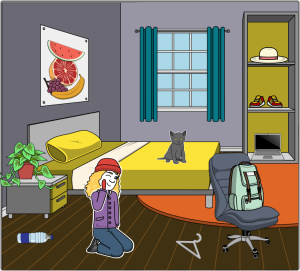
- Ein Bild hängt an der Wand.
- Eine Katze sitzt auf dem Bett.
- Das Fenster ist hinter der Katze.
- Es gibt einen Computer in dem Regal.
- Ein Nachttisch steht neben dem Bett.
- Ein Bild hängt über dem Bett.
- Das Bett steht unter dem Bild.
- Paulina sitzt auf dem Boden vor dem Bett.
- Paulina sitzt zwischen der Wasserflasche und dem Kleiderbügel.
In all of these examples, we are describing where things are located. These things are not moving—just staying in the location. When you are describing where things are located with these two-way prepositions, use the dative case.
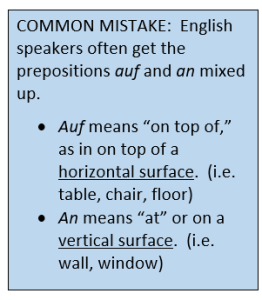

Beispiel: Wo ist das Buch? Es liegt auf dem Tisch. (Audio courtesy of Jeuwre, Creative Commons Attribution-Share Alike 4.0 International.)
If you want a song to help you learn these prepositions, here’s one with dancing flamingos:
Check your understanding of two-way prepositions with Claudia Kost’s and Crystal Sawatzky’s (University of Alberta) fill-in-the-blank exercise:
Ex. A: Wo ist die Wasserflasche? Using the two-way prepositions, describe where everything else is located in the picture above. Some questions may have more than one possible answer.
Beispiel: Wo ist die Wasserflasche?
→Die Wasserflasche ist auf dem Boden.
→Die Wasserflasche ist neben Paulina.
→Die Wasserflasche ist neben dem Nachttisch.
- Wo ist der Rucksack?
- Wo ist die Pflanze?
- Wo ist der Hut?
- Wo sind die Schuhe?
- Wo ist der Stuhl?
- Wo ist das Bett?
- Wo ist der Teppich?
- Wo ist das Fenster?
- Wo ist die Gardine?
Listen to Faun’s song, Diese kalte Nacht (2013), to hear examples of the dative case with two-way prepositions.
Verbs of Location:
Often when describing location of things, you will hear the following verbs:
- stehen—to stand, to be standing, to be located in a standing position
- liegen—to lie, to be located in a horizontal position
- hängen—to hang, be hanging in a vertical position
Although you can easily use the verb sein to describe where these things are located, using these new verbs gives more detail.
- Der Rucksack steht auf dem Stuhl.
- Die Wasserflasche liegt auf dem Boden.
- Die Schuhe stehen in dem Regal.
Ex. C: Beschreiben Sie Ihr Klassenzimmer! Wo steht alles? Verwenden Sie dabei die Verben stehen, hängen und liegen.
Beispiel: Der Schreibtisch steht vor der Tafel…
Contractions:
Some of the two-way prepositions can form contractions.
- an + dem = am
- in + dem = im
You may have wondered why we sometimes use im instead of in. Im is just the short form for in dem—“in the.”
- Es gibt 18 Tische im Klassenzimmer. (in dem Klassenzimmer)
- Eine Frau steht am Fenster. (an dem Fenster)
DON’T USE “IM” FOR EVERYTHING! IF YOU WOULDN’T SAY “IN THE,” DON’T USE “IM”!!!
Watch Easy German’s video to see lots of examples with two-way prepositions in slow German.
Try Claudia Kost’s and Crystal Sawatzky’s (University of Alberta) fill-in-the-blank exercise before moving on:
Ex. D: Ihr Zimmer. Beschreiben Sie Ihr Zimmer. Was gibt es? Wo steht alles? (Mindestens 10 Sätze)
Beispiel: Eine Lampe steht auf meinem Schreibtisch. Ein Poster hängt an der Wand…usw.
Ex. E: Beschreiben Sie das Badezimmer und die Küche. Wo steht alles? Verwenden Sie dabei die Verben hängen, liegen und stehen.
Beispiel: Das blaue Kleid liegt auf dem Boden.
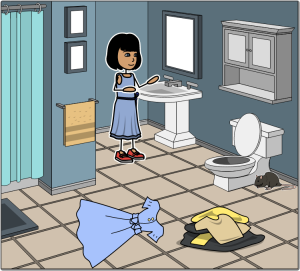
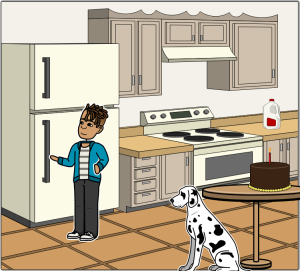
Ex. F: Im Haus. Listen to the audio (used with permission from germanlistening.com) and answer the questions about Tonis Haus.
Ex. G: Beschreiben Sie Ihr Haus! Welche Zimmer haben Sie? Was gibt es in jedem Zimmer? (Listen to the sample audio clip of Salome describing her apartment in Berlin, courtesy of Salome from AudioLingua. The two-way prepositions begin around the 0:14 mark.)
Ex. H: Beschreiben Sie! Das Kinderzimmer, der Dachboden, der Keller, und das Wohnzimmer.
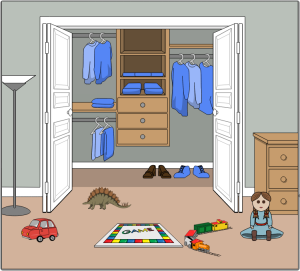
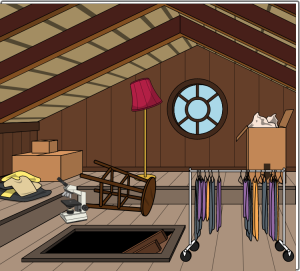
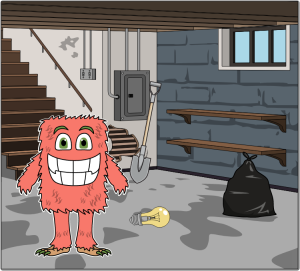
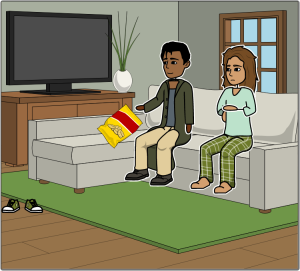
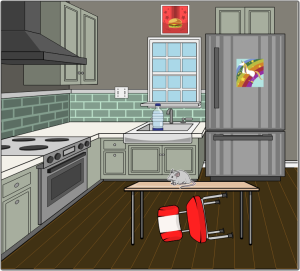
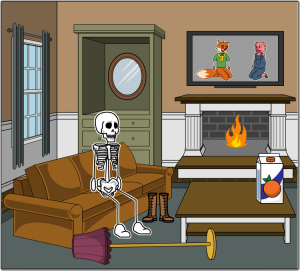
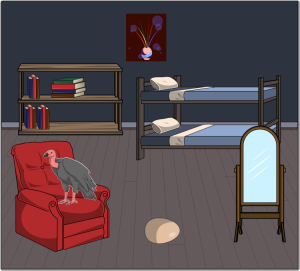
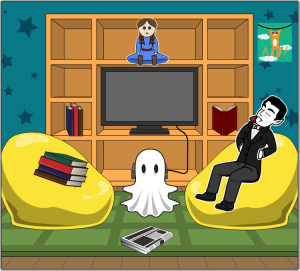

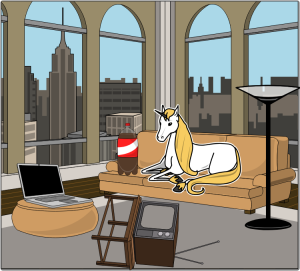
Deutsche Musik. Listen to Mark Forster’s song, Au revoir (2014), which has several two-way prepositions, present tense, and conversational past.
Two-Way Prepositions in the Accusative Case:
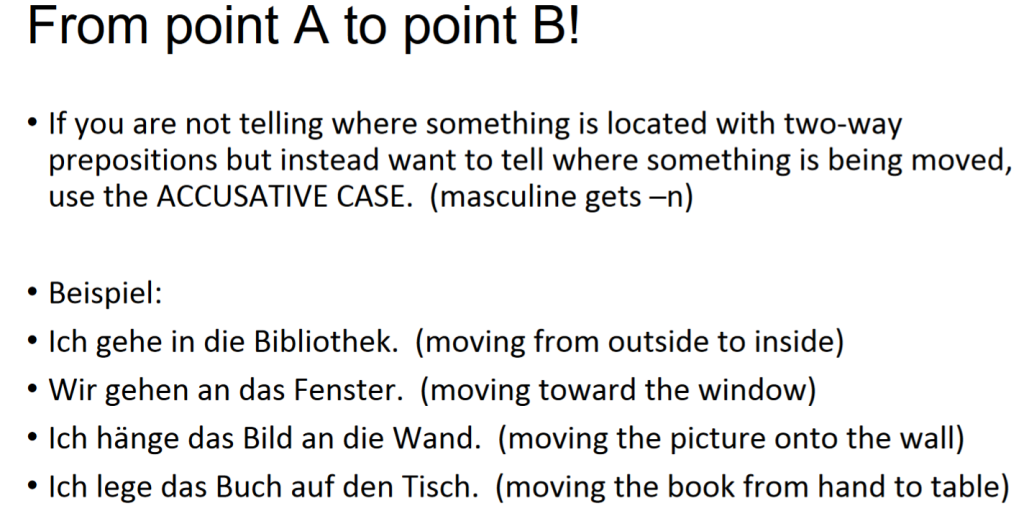
Er springt über den Football.
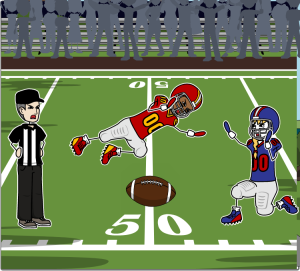
In this instance, the player is actively moving. He is going from Point A on one side of the football to Point B on the other side. We are describing a destination, not a location. Therefore, we use the accusative.
Das Einhorn springt über den Mann.
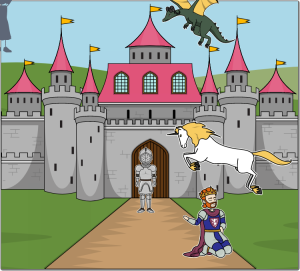
The unicorn is actively moving from one location to another. Therefore, we use the accusative.
Der Drache fliegt über das Schloss.
Since the dragon is actively flying from one location to another, we use accusative. (Der Drache, by the way, is an n-noun.)
Der Ritter steht vor dem Schloss.
The knight is NOT moving. He is staying in one location. Therefore, we use the dative.

Das Mädchen springt über die Kuh.
The girl is moving from one location to another so we use accusative after two-way preposition über.
Die Kuh steht unter dem Mädchen.
The cow is not moving to a new location so we use dative after two-way preposition unter.

HOW TO KNOW WHEN TO USE ACCUSATIVE OR DATIVE:
- When using two-way prepositions, if you are moving yourself or something from point A to point B, use the ACCUSATIVE case.

Motion—Accusative: like a MAC truck.
A→B
Wir gehen in die Küche.
Er hängt das Bild an die Wand.
Der Vogel fliegt vor das Haus.
- When you or something is not being moved, use the DATIVE case.
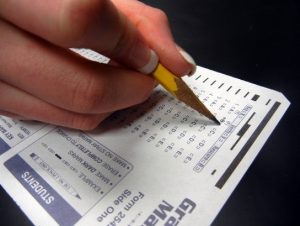
No Motion—Dative: like when you take a standardized test and you don’t move for hours and hours (the NM-DAT test)
Wir sitzen in der Küche.
Das Auto steht neben der Garage.
The motion vs. no-motion aspect also applies to things that you move from one location to another.

Sie hängt das Foto an die Wand.
Because the girl is moving the photo from one location to another, i.e. from point A to point B, we use the accusative after the two-way preposition an.
Das Bild hängt an der Wand.
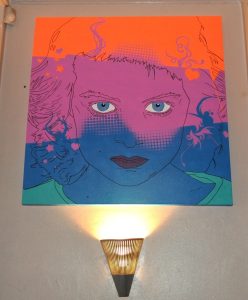
This picture is already on the wall. It is not moving. It is in one location. Therefore, we use the dative case after the two-way preposition an.

Der Junge legt den Teller auf den Tisch.
The boy is moving the plate from one location to another, so we use the accusative after the two-way preposition auf.
Die Teller und Gläser sind schon auf dem Tisch.
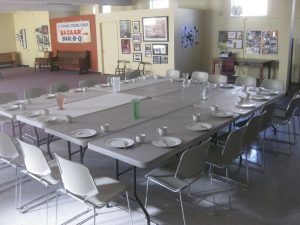
The plates and glasses are on the table and not moving. They are in one location, so we use the two-way preposition auf.
Deutsche Musik: Listen to Silbermond’s song Unter der Oberfläche (2012) to hear examples of the two way preposition unter with both the accusative and dative cases.
Verbs for “to put”:
There are several verbs that mean “to put” that you can use 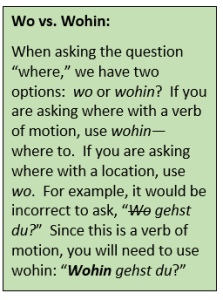 when moving objects from one location to another.
when moving objects from one location to another.
- stellen—to place in an upright, standing position, to stand something up
- hängen—to hang up in a vertical position
- legen—to put in a horizontal position, to lay
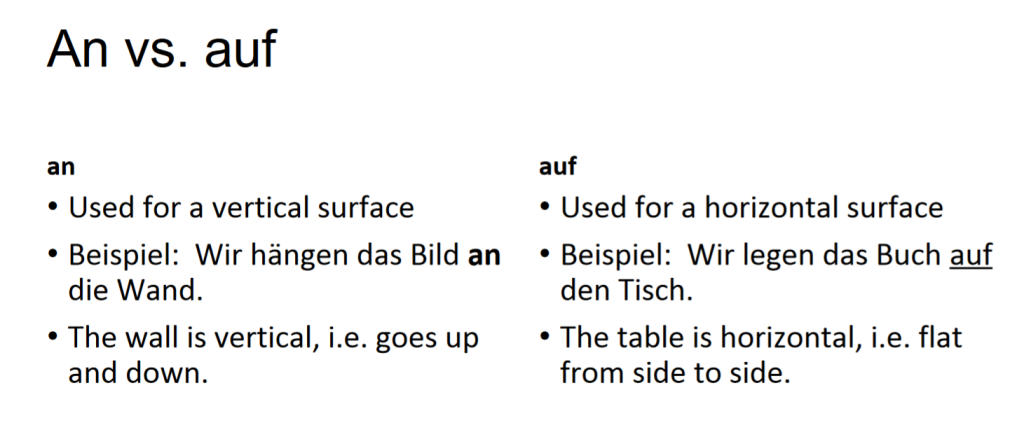
One note about in vs. auf:
In English, we sometimes use prepositions in a way that is not quite accurate. For example, we ride on the bus instead of in the bus. We also ride on planes and trains instead of in them.
Germans actually ride INSIDE these vehicles. Use in when expressing these ideas in German.
Wir sitzen in dem Bus. ODER Wir sitzen im Bus.
auf dem Bus VS in dem Bus (im Bus)


Contrarily, English sits in chairs, not on top of them. German is more literal and sits on chairs.

Der Hund sitzt auf dem Stuhl. (Not inside it!!!)
Watch YourGermanTeacher’s video to see him reteaching this:
Or watch Anja’s video to see real life examples:
Ex. L: Beschreiben Sie die Bilder!
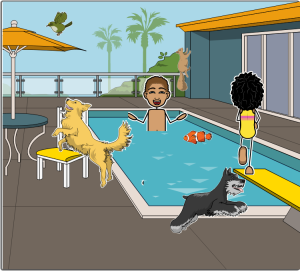
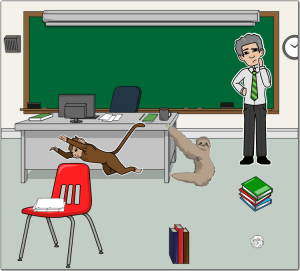
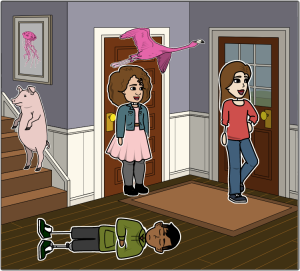
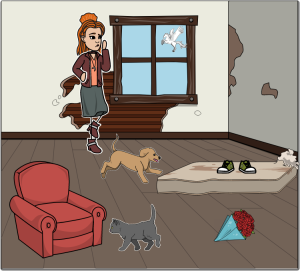
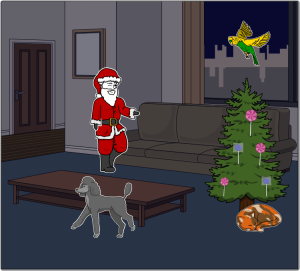
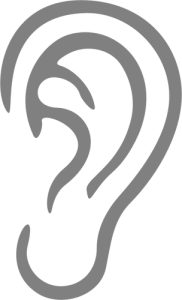 QUICK LISTENING: Listen to the description of the buildings in the city. You will hear several two-way prepositions that describe where the buildings are in relation to each other. Fill in with the prepositions you hear. (Used with permission from Germanlistening.com).
QUICK LISTENING: Listen to the description of the buildings in the city. You will hear several two-way prepositions that describe where the buildings are in relation to each other. Fill in with the prepositions you hear. (Used with permission from Germanlistening.com).
Ex. M: Nicos Weg. Episode 55: Ausflug. Watch the episode and do the online activities. You will review conversational past and when to use the helping verb haben or sein.
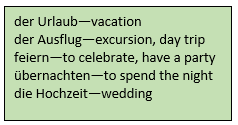
https://learngerman.dw.com/en/der-ausflug/l-37651657
Ex. N: Nicos Weg. Episode 56: Wie wird das Wetter? Watch the episode and do the online activities. You will review how to talk about the weather in present and past tense.
https://learngerman.dw.com/en/wie-wird-das-wetter/l-37653197
Ex. O: Nicos Weg. Episode 57: Das ist jetzt modern! Watch the episode. Doing the online activities is optional. If you do, you will learn some new adjective endings for ein-words. We will do these in a later chapter.
https://learngerman.dw.com/en/a1e14l1/l-37655848
Ex. P: Nicos Weg. Episode 58: Mein Lieblingspulli. Watch the episode and do the online activities. You will review clothing and demonstrative adjectives, such as dies– and welch-, which you learned in Chapter 3.
https://learngerman.dw.com/en/mein-lieblingspulli/l-37656274
Ex. Q: Nicos Weg. Episode 59: Das passt gut! Watch the episode and do the online activities.
https://learngerman.dw.com/en/das-passt-gut/l-37661740
Extra Practice with rooms of the house vocab:
Watch Easy German’s video to see the preposition in with both accusative and dative examples.
Watch Easy German’s video to see a tour of a Berliner apartment using the vocabulary you just learned.
Watch Easy German’s videos to see examples of two-way prepositions in both the accusative (motion) and dative (location/no-motion).

